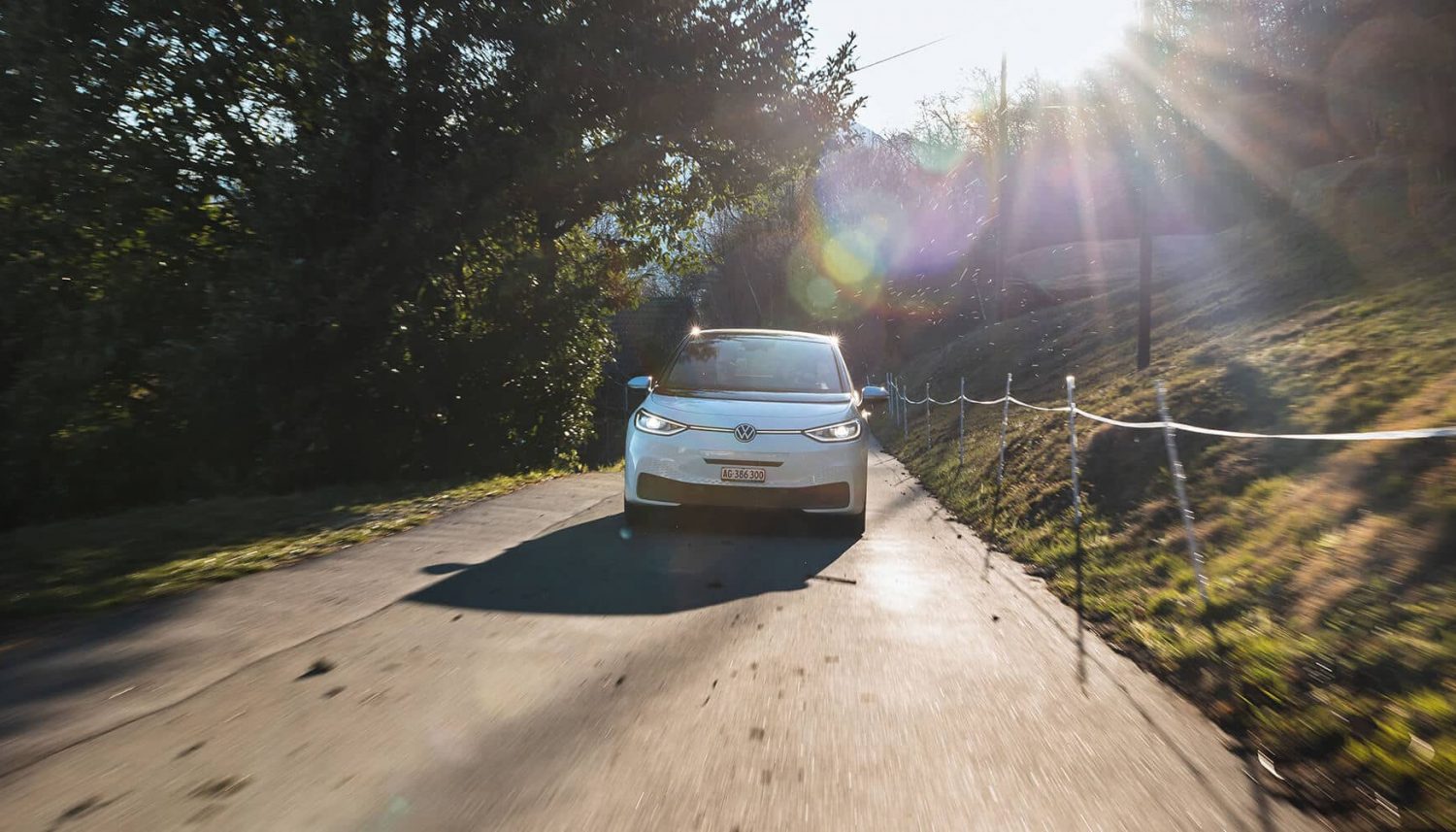
Myth 1: “Electric cars are expensive”
Myth 2: “Electric cars have a low range”
Myth 3: “Electric cars take a long time to charge”
Myth 4: “The battery doesn’t have enough power”
Myth 5: “Electric cars aren’t safe”
Myth 6: “Electric cars do nothing to improve the environment”
Myth 7: “Electric cars are anything but electrifying”
Myth 8: “Electric cars overload the power grid”
Myth 9: “There is a lack of raw materials”
Myth 10: “Electric cars are a danger to bicycles and the visually impaired”
Myth 1: "Electric cars are expensive"
Reality: On the contrary – key words: useful life and total costs.
Times have changed, electric cars are becoming more affordable and battery costs have fallen by around 80% in recent years (1). Many cantons also offer purchase incentives for electric cars as well as the appropriate charging infrastructure. The running costs of the electric car are lower over its useful life, and if you take a look at the TCO (Total Cost of Ownership), you’ll see that the electric car is an investment that pays off. In terms of running costs, the greatest savings potential for electric vehicles lies in the area of energy, service and maintenance costs. In this area, the electric car has significant advantages over combustion engines.
Myth 2: "Electric cars have a low range"
Reality: Today, electric cars can travel 300 to 600 km on one charge.
Depending on the battery size, tyres, body type and, above all, driving style, modern electric cars can now easily cover several hundred kilometres on a single charge (3). Planning a longer driving distance? Long distances have long been a possibility with the electric car. Almost 600 charging points with a charging capacity of between 50 and 350 kW are available in Switzerland (2). The number of charging stations is steadily increasing, both in public spaces and private households. And the technology for fast charging stations is advancing too, which further reduces charging times on the road.
Myth 3: "Electric cars take a long time to charge"
Reality: Fast charging stations can charge up to 300 km in just 20 minutes.
Charging is not the same as refuelling. Electric cars are usually charged where they are parked for long periods of time – at home or in the office. Therefore, the charging time is often rather insignificant. On a long journey and need to charge quickly? No problem. In Switzerland, there is a growing fast-charging network with almost 600 stations and up to 20 DC charging points per station. The charging power at the fast-charging stations is now between 50 and 350 kW, which corresponds to a range increase of 250 to 750 kilometres per hour (2). Under ideal conditions, you can charge your battery from 5% to 80% in just under 30 minutes (4).

Myth 4: "The battery has a short service life"
Reality: Lithium-ion batteries are reliable and long-lasting.
The service life of your electric car battery depends on how often it is charged and discharged. Vehicle manufacturers also provide long-term guarantees over long driving distances. VW, for example, gives you a guarantee that the battery will not fall below at least 70% of the value of the usable capacity after eight years or 160,000 km (4). The batteries are actively cooled or warmed and the battery management system balances the voltage of the individual cells to ensure optimum performance. And what if the battery’s service life ends up being exceeded at some point? Dispose of it as special waste? Of course not! The battery is normally used for stationary use, as so-called buffer storage. Only after that – and we’re now seeing expected service lives of 20 to 25 years – will the battery be recycled. Did you know? It’s now possible to recycle 96% of a lithium-ion battery.
Myth 5: "Electric cars aren't safe"
Reality: Even cold and wet conditions pose no danger to your electric car.
Electric cars guarantee the highest level of safety thanks to special safety systems. The current flow of the battery is immediately interrupted in the event of an accident, for example. In addition, electric cars do not carry flammable and explosive liquids and the risk of fire is just as low as with internal combustion vehicles, according to various tests. The heavy underbody (battery) minimises the risk of tipping over and the small electric motor means that there’s no heavy engine block that could be pushed into the driver’s compartment in the event of a crash. Charging is completely harmless, even when carried out in the rain, for example. After all, if the battery and charging station comply with the standard, no current will flow until a safe contact has been established. Even during a thunderstorm, your electric car is safe just like any other car (4).
Myth 6: "Electric cars do nothing to improve the environment"
Reality: No type of drive has a better carbon footprint than the electric car.
It is true that battery production produces around 20% more CO2 than diesel vehicle production. Over their entire service life, however, electric vehicles cause only half the greenhouse gas emissions compared to a petrol vehicle (3). Electric cars therefore make an important contribution to climate protection. And they’re becoming even more environmentally friendly as green power grows. In Switzerland, electric cars are already more environmentally friendly than combustion engines after just a short driving distance. This is thanks to a clean electricity mix with a high proportion of hydropower (4). Even better and most sustainable: charge the electric car with your own solar power.
Myth 7: "Electric cars are anything but electrifying"
Reality: Go from 0 to 100 km/h in under 4 seconds with your electric car.
No clutch needed to set off, and you can go from a standstill to the top speed within a few seconds. This is what you’ll get with the powerful electric motors – butterflies in the stomach guaranteed. The absence of the quick-tempered engine has little to do with performance, but possibly a lot to do with the enduring myth. And the acceleration process can also be reversed to slow down the vehicle: In recuperation mode, the engine functions as a generator brake, with energy flowing back into the battery (7). A win-win scenario.

Myth 8: "Electric cars overload the power grid"
Reality: We would easily cope with a boom in electric cars.
If all petrol cars were replaced by electric cars today (approx. 6.3 million vehicles), 10 to 15% more electricity would be needed in Switzerland. This is no mean feat, especially in view of the phase-out of nuclear power. If this issue is tackled consistently from now on, and a technical solution found regarding the expansion of photovoltaics and possible storage of summer surplus energy, then Switzerland’s electricity supply should be secure in the long term (5). Clyde’s parent company AMAG is already intensively committed to the expansion of renewable energies. For another challenge, namely ensuring grid stability, electric vehicles could even be part of the solution. Keyword: bi-directional charging. The vehicle battery functions here as an intermediate store of electrical energy (e.g. to store surplus solar power), which makes it possible to cook the evening meal using regenerative energy, even when the sun is no longer shining.
Myth 9: "There is a lack of raw materials"
Reality: There is enough lithium, and cobalt is being used less and less.
There are sufficient raw materials available, and batteries are continually being further developed and sustainably recycled. The proportion of cobalt is to be significantly reduced in the medium term and reduced to zero in the long term. With the known lithium deposits, batteries for billions of electric cars could already be produced according to the current state of the art (4). While the combustion engine has been developed over several decades, electromobility is still in its infancy. In the field of battery development, there’s a lot that can be expected in the future.
Myth 10: "Electric cars are a danger to bicycles and the visually impaired"
Reality: Not with the artificial driving noise at low speeds.
Electric cars make a significant contribution to reducing traffic noise and improving overall health thanks to their quiet operation. They also help to reduce costs that would otherwise be passed on to uninvolved third parties. The added value of low-noise electromobility benefits not only electric car drivers, but also the general public. In order for electric cars to be perceptible to people with impaired vision or cyclists, they must be equipped with an acoustic warning system, known as the “Acoustic Vehicle Alerting System” (AVAS), which emits an artificial driving noise at speeds of up to 20 km/h (5). At faster driving speeds, the aerodynamic noise and the rolling noise of the tyres are louder than the artificially generated sound.
Smarter?
Electromobility has freed itself from many myths and preconceptions. Modern electric vehicles are no longer niche products, but rather a realistic and sustainable alternative to conventional combustion engines. The technology is developing rapidly and more and more people are recognising the benefits of electric mobility for the extremely dynamic, pleasant driving experience that is easy on the wallet and the environment. We say “goodbye” to the myths and “hello” to Clyde’s electric car subscription.


